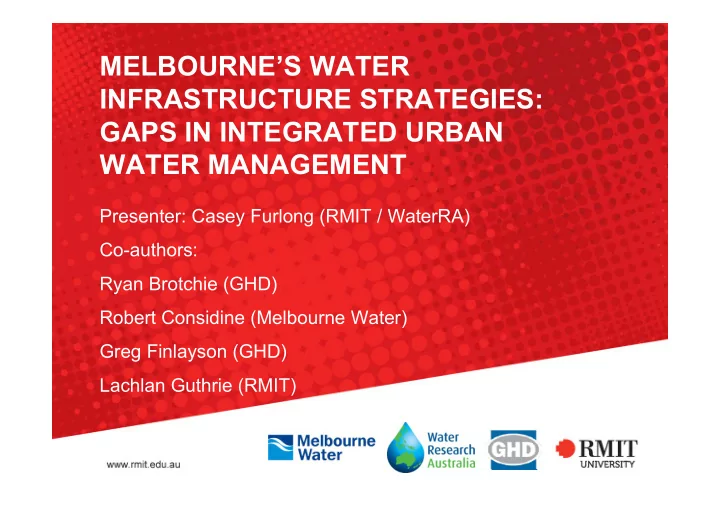

MELBOURNE’S WATER INFRASTRUCTURE STRATEGIES: GAPS IN INTEGRATED URBAN WATER MANAGEMENT Presenter: Casey Furlong (RMIT / WaterRA) Co-authors: Ryan Brotchie (GHD) Robert Considine (Melbourne Water) Greg Finlayson (GHD) Lachlan Guthrie (RMIT)
Content of presentation 1. Melbourne’s challenges 2. Infrastructure responses 3. Planning for uncertainty 4. Integrated Urban Water Management 5. IUWM strategy case studies 6. Proposed IUWM infrastructure solutions 7. Gaps in IUWM processes 8. Discussion and conclusion RMIT University - Casey Furlong
Melbourne's challenges 1000 WWII drought (10 years) Average rainfall Millennium Drought (12 years) 1936‐1945: 574 mm/yr 1900‐2014: 648 mm/yr 1997‐2009: 561 mm/yr (‐11%) 900 (‐13% from average) Federation Drought 1895‐1902* 800 • 4 million people now, 8 million 700 people by 2050, increasing Average rainfall (mm) 600 demand on services 500 400 • Urban footprint will increase by 300 200 43% by 2050 100 0 • Impacts of urbanisation on 1900 1903 1906 1909 1912 1915 1918 1921 1924 1927 1930 1933 1936 1939 1942 1945 1948 1951 1954 1957 1960 1963 1966 1969 1972 1975 1978 1981 1984 1987 1990 1993 1996 1999 2002 2005 2008 2011 2014 Year *Federation drought is formally between 1885-1902, however rainfall data is not avalaible prior to 1900 waterways & bays (from stormwater runoff & wastewater discharges) • 1997 - 2009 drought:13% decrease in rainfall led to 39% decrease in reservoir inflows RMIT University - Casey Furlong
Infrastructure and policy responses during and post drought • Major desalination plant (one third of city’s current demand) • Inter-basin transfer pipeline • Combined capital cost > $5B • 20% water recycling target set and achieved (mostly agricultural) • Water efficiency campaign: Target 155 (L/person/day) • Incentives for rainwater tanks RMIT University - Casey Furlong
Planning for uncertainty: population and climate • Climate change predicted to result in reduced rainfall & inflows, with more intense rainfall events & sea level rise • Population forecasts revised often, high variation • Climate change and uncertainty government priority 2004 – 2011 • Scenario planning conducted to plan for uncertain future RMIT University - Casey Furlong
Integrated Urban Water (Cycle) Management • 2009 onwards IUWM has become popular • Strategic, long-term, integrated planning approach which considers all water services, sources, stakeholders, and impacts in order to create the best possible community outcomes • Associated with recycled water and stormwater harvesting • Planning done through IUWM Strategies/Plans RMIT University - Casey Furlong
IUWM Strategies/Plans • This research has considered 9 Problem definition strategies Assembling of Setting of Risk management stakeholders objectives • Various scales of investigation: residential housing developments up to one third of Identification of possible options Melbourne BAU option IUWM options Removal of development development unfeasible options • Investigate variety of options including stormwater to Option selection potable/non-potable, wastewater Technical Cost benefit Multi criteria to non-potable & rainwater tanks evaluations analysis assessment • Do not consider wastewater to potable Option implementation Implementation plan with Recommendation of options next steps RMIT University - Casey Furlong
RMIT University - Casey Furlong
Proposed IUWM infrastructure solutions 1. Collection of stormwater in wetlands and then treatment and injection to potable network 2. Non-potable reuse from wastewater treatment plants, sewer mining and stormwater harvesting RMIT University - Casey Furlong
Financial assessment of IUWM options • Options compared using Long Run Marginal Costs, shown that IUWM solutions will cost more than business as usual • In some cases up to $700M more, but in others only slightly • Justified through environmental, liveability and resilience benefits RMIT University - Casey Furlong
Gaps in the IUWM strategy processes • Consideration of climate change projections • Scenario planning (single possible future scenario used) • Demonstration or valuation of resilience/liveability • Justification for environmental targets (no clear policies exist) Lower rainwater and Increased water Lower water stormwater yields Flooding demand supply yields (and runoff) Climate change impacts Enviro Changes to or annual Sea Level flow Seasonal variability Irrigation Seasonal intensity Rainfall changes rainfall Inflow events Urban demands Rise 1 Botanic Ridge Growth Area 2 East Pakenham 3 Casey Clyde Growth Area 4 WFN: Growth Areas 5 Water Future Central 6 Fishermans Bend 7 Melton Growth Area 8 Sunbury Growth Area 9 Western Region Water Balance RMIT University - Casey Furlong
Discussion • IUWM is extremely difficult and complex primarily because it involves attempting to justify additional costs through non-monetary benefits • Significant cost increases are partially justified through environmental benefits to waterways, but there is no clear policy guidance to provide justification • The IUWM solutions proposed are more climate independent than dam water supplies, but less than desalination and direct potable reuse which were not considered • Strategies do not use scenario planning and so fail to assess resilience • Strategies generally failed to incorporate climate change projections, and it is not clear how significant an impact this would have on recommendations RMIT University - Casey Furlong
Conclusion • IUWM processes can help with climate change adaptation, particularly if all options are considered including desalination and potable reuse • What you need to effectively conduct IUWM strategies are: 1. Clear environmental targets 2. Scenario planning 3. A financial assessment methodology which allows investigations at different scales (e.g. Long Run Marginal Costs) RMIT University - Casey Furlong
Acknowledgements • Co-authors • RMIT University, Water Research Australia, GHD and Melbourne Water Corporation RMIT University - Casey Furlong
Recommend
More recommend